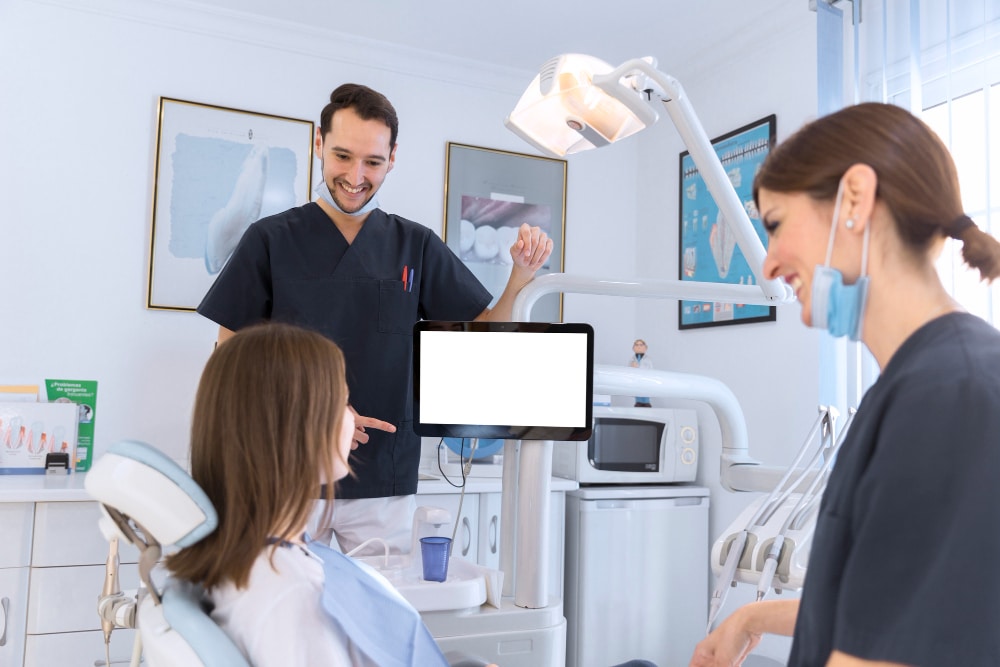Marketing is changing faster than ever before, and businesses across all industries need to keep up. Orthodontics is no exception. With the rise of new technologies and the evolution of digital platforms, the way orthodontists reach and engage with potential patients is transforming. As we move forward, it’s essential to understand how these trends will shape the future of orthodontic marketing. From AI-driven tools to more personalized patient experiences, orthodontic practices need to stay informed to remain competitive in the future of orthodontic marketing.
The Future of Orthodontic Marketing
Key Trends to Watch
As digital marketing continues to evolve, so does the landscape of orthodontic marketing. Here are some key trends that will shape the future of how orthodontic practices reach and engage with patients.
1. Personalized Patient Experience Through AI and Automation

One of the most significant changes in orthodontic marketing is the growing use of artificial intelligence (AI) and automation. These technologies allow practices to provide a more personalized experience to their patients. AI-powered tools can streamline many aspects of marketing, from responding to patient inquiries in real time with chatbots to automatically sending out appointment reminders. This level of automation saves time and creates a seamless experience for the patient, which can help build trust and foster long-term relationships.
Additionally, AI can be used to analyze patient data and make more informed marketing decisions. For example, orthodontic practices can use data to predict when patients might need follow-up care, offering more targeted promotions or services at the right time. As AI and automation become more advanced, they will continue to play a critical role in shaping the future of orthodontic marketing.
2. The Rise of Video Marketing for Orthodontists
Video marketing has exploded in recent years, and it’s quickly becoming a key component of the future of orthodontic marketing. Videos are highly engaging and can showcase the results of orthodontic treatments in a way that written content simply can’t. Patients are often more likely to trust a practice when they can see real-life results, whether through patient testimonials, treatment progress videos, or behind-the-scenes looks at the practice.
Orthodontists can also use platforms like YouTube, Instagram Reels, and TikTok to reach a wider audience. Short, engaging videos that highlight treatment benefits, patient journeys, or even educational content can help practices build a strong online presence. As video continues to grow in popularity, orthodontic practices that invest in high-quality video content will be well-positioned to stand out in the market.
3. Embracing Local SEO and Hyperlocal Targeting
Search engine optimization (SEO) has always been important, but with more patients searching for local services online, orthodontists must focus on local SEO. Optimizing your practice’s website for local search terms can increase visibility and attract patients within your community. This includes claiming your Google My Business profile, encouraging patients to leave reviews, and creating location-specific content that addresses the needs of local patients.
Hyperlocal targeting takes this a step further by focusing on smaller, community-based marketing efforts. Orthodontic practices can target specific neighbourhoods or even zip codes with tailored ads and content. By narrowing down the audience, practices can create more personalized messages that resonate with potential patients close to their office. This shift towards local and hyperlocal SEO is a key part of the future of orthodontic marketing, ensuring that practices can reach the right people at the right time.
Social Media Marketing: Expanding Reach Beyond Traditional Methods
As social media platforms continue to evolve, they present orthodontic practices with new opportunities to engage potential patients in innovative ways. Social media is no longer just a place to post occasional updates. It’s become a crucial marketing tool for reaching a wider audience and building trust through direct interaction. By strategically using these platforms, orthodontic practices can expand their reach and connect with patients on a more personal level.
1. Influencer Collaborations and Partnerships
Influencer marketing has grown significantly, and orthodontic practices can benefit by collaborating with influencers who have a local following or specific influence in healthcare. Partnering with micro-influencers in the dental or wellness space can help promote your practice to their audience in an authentic way. These partnerships create trust, as influencers often share personal stories or recommendations with their followers, making their endorsements highly effective.
Working with influencers also allows orthodontic practices to showcase their treatments and services to potential patients who may not have previously considered orthodontic care. Whether it’s a local wellness advocate sharing their experience with Invisalign or a beauty blogger documenting their journey with braces, these collaborations can create organic, engaging content that resonates with your target audience.
2. Instagram and TikTok: Visual Platforms that Drive Patient Engagement
Instagram and TikTok have become essential platforms for orthodontists to reach younger audiences and engage patients in creative ways. These platforms are perfect for orthodontic practices to share before-and-after images, patient testimonials, educational content, and behind-the-scenes glimpses of life in the clinic.
For example, practices can use Instagram stories to answer common questions about orthodontic treatments or share fun, short videos on TikTok to explain procedures like braces or aligners in a visually engaging way. Using these platforms not only allows orthodontists to showcase their expertise but also humanizes the practice, making it more approachable for patients.
Visual content can also increase engagement by helping potential patients imagine what their own treatment results might look like. As more people consume video and image-based content, orthodontic practices that leverage these platforms will have a better chance of standing out.
3. Paid Social Media Advertising for Immediate Results
While organic social media growth is valuable, paid advertising on platforms like Facebook, Instagram, and TikTok allows orthodontists to target specific audiences quickly. These ads can be customized based on location, demographics, and even behaviour, ensuring that your practice is reaching the right people at the right time.
For instance, a practice could run Facebook ads targeting parents within a 10-mile radius who are interested in orthodontic treatments for their children. Similarly, Instagram ads showcasing clear aligners could be aimed at young adults considering more discreet orthodontic options. Paid social media advertising delivers fast results and is a cost-effective way to grow your patient base, making it a key part of the future of orthodontic marketing.
Data-Driven Marketing: Predicting the Future of Orthodontic Marketing
Data is becoming one of the most valuable tools for businesses across all industries, and orthodontic marketing is no exception. With more tools available to track and analyze data, practices can make smarter decisions about their marketing strategies for orthodontics. Leveraging this data allows orthodontists to understand patient behaviour, optimize their marketing efforts, and predict future trends in the industry.
1. Leveraging Data Analytics for Smarter Decisions
Data analytics is no longer just for large corporations; orthodontic practices can now access valuable insights about their patients and potential leads. Tools like Google Analytics, social media insights, and customer relationship management (CRM) systems provide a wealth of information. Practices can track everything from website traffic to patient inquiries and conversions, allowing them to measure the effectiveness of their marketing campaigns.
For instance, by tracking how patients find your website (whether through search engines, social media, or direct referrals), you can adjust your marketing efforts accordingly. If you notice a spike in Instagram visits after posting educational content, it may signal that investing more time in that platform will yield even better results. This kind of data allows orthodontists to make informed decisions, increasing the overall efficiency of their marketing efforts.
2. Predictive Analytics to Forecast Patient Behavior
As orthodontic marketing becomes more data-driven, predictive analytics is emerging as a powerful tool. Predictive analytics uses historical data to forecast future outcomes. For orthodontists, this means understanding when patients are most likely to seek treatment or return for follow-up care.
For example, suppose a patient completed their Invisalign treatment a year ago. In that case, predictive analytics can help determine the best time to send them a reminder about a follow-up consultation or promote additional services. By anticipating patient needs, practices can create timely and personalized marketing campaigns that keep patients engaged.
This approach not only improves patient retention but also helps practices better manage their resources. Instead of relying on guesswork, orthodontists can use data to predict when a patient might be considering treatment and offer targeted promotions or information. The use of predictive analytics is a forward-thinking strategy that will become increasingly vital in the future of orthodontic marketing.
Omnichannel Marketing: Seamlessly Connecting Online and Offline Experiences
In today’s competitive market, orthodontic practices must ensure that their patients have a consistent experience across all touchpoints, both online and offline. This approach, known as omnichannel marketing, allows practices to provide a seamless and cohesive experience for patients, whether they’re interacting with the practice’s website or social media or visiting the office in person. Creating a unified brand presence across multiple channels is essential for building trust and ensuring that patients remain engaged throughout their treatment journey.
1. Coordinated Efforts Across All Platforms
For orthodontic practices, omnichannel marketing means ensuring that every platform—whether it’s a website, social media, email, or even phone interactions—delivers a consistent message and experience. Patients should feel the same level of care and professionalism when they visit the practice’s Instagram page as they do when they step through the doors for an appointment. The goal is to create a cohesive and engaging brand experience that builds confidence and fosters long-term patient relationships.
This might involve using the same branding, messaging, and tone of voice across all platforms, but it’s also about aligning your marketing strategies. For example, an orthodontic practice can use social media to promote a new service, while the website offers detailed information, and email campaigns provide personalized updates to potential patients. The key is ensuring that all these efforts are connected and that the patient’s experience remains consistent at every point of contact.
2. How to Integrate Digital Tools into Your Orthodontic Practice
The success of omnichannel marketing often hinges on using the right digital tools to integrate and manage various channels. Orthodontic practices can streamline their marketing efforts by using customer relationship management (CRM) systems, email marketing platforms, and social media management tools. These systems help ensure that all patient interactions are tracked, allowing practices to follow up with personalized content, reminders, and offers.
For example, when a potential patient visits your website and fills out a contact form, that information can be automatically logged into your CRM. From there, the system can trigger follow-up emails that provide more information about the services they’re interested in, such as Invisalign or braces. Similarly, when a patient books an appointment through an online scheduling tool, the system can send reminders and even personalized pre-appointment instructions.
Patient-Centered Content: Engaging and Informing Your Audience

In the future of orthodontic marketing, creating content that centers around patient needs and concerns will be more important than ever. Patients are looking for helpful, relevant information that addresses their specific questions about treatments, services, and what to expect during their orthodontic journey. By developing patient-centered content, orthodontic practices, along with an orthodontic marketing agency, can engage not only current patients but also attract new ones by establishing themselves as trusted sources of information.
Educational Content is Key
One of the most effective ways to engage your audience is by providing educational content that answers common questions and addresses patient concerns. Whether it’s through blog posts, social media updates, or email newsletters, orthodontic practices should focus on creating content that explains procedures, highlights the benefits of different treatment options, and guides patients through every step of their care.
For example, blog posts discussing topics such as “What to Expect During Your First Braces Appointment” or “How to Care for Your Clear Aligners” can provide valuable insights to prospective patients. Educational videos or tutorials explaining treatment procedures can also be powerful tools to demystify orthodontic care and make it more approachable. Practices that consistently share helpful, informative content will build stronger relationships with their audience and be seen as experts in their field.
User-Generated Content to Build Trust
Encouraging patients to share their experiences through user-generated content (UGC) can help build trust and credibility for your practice. Potential patients often look for social proof when deciding where to get treatment, and reviews, photos, or testimonials from existing patients can have a big impact.
Orthodontic practices can ask patients to share before-and-after photos of their smiles or post reviews about their treatment experience on social media platforms. These real-life stories and images create a sense of authenticity that’s hard to replicate with traditional marketing. UGC allows practices to showcase actual patient results and experiences, giving future patients a more realistic idea of what they can expect.
FAQs About the Future of Orthodontic Marketing
As the marketing landscape continues to evolve, orthodontic practices are looking for new ways to adapt and grow. Below are some frequently asked questions regarding the future of orthodontic marketing and how these changes might affect your practice.
1: How will AI impact orthodontic marketing?
AI will significantly streamline marketing efforts for orthodontic practices. It can automate tasks such as responding to inquiries, sending appointment reminders, and analyzing patient data to provide personalized treatment recommendations. AI-driven marketing tools will make it easier to engage patients, optimize campaigns, and deliver a better overall experience.
2: What is hyperlocal SEO, and how does it help orthodontists?
Hyperlocal SEO focuses on optimizing your practice’s online presence to target specific neighbourhoods or communities rather than broader geographic areas. By using hyperlocal SEO strategies, orthodontic practices can appear in search results for patients who are nearby and actively searching for services. This strategy increases visibility in your local community and helps you attract patients who are most likely to convert.
3: How can data analytics improve orthodontic marketing?
Data analytics provides insights into how patients interact with your website, social media, and other marketing efforts. By analyzing this data, practices can track the effectiveness of campaigns, understand patient behaviour, and make more informed marketing decisions. This data-driven approach allows for better targeting and more personalized marketing efforts, ultimately improving patient acquisition and retention.
4: How important is mobile optimization for orthodontic websites?
Mobile optimization is critical for the future of orthodontic marketing. Most patients search for services on their smartphones, so having a website that is mobile-friendly improves user experience and search engine rankings. A well-optimized mobile site makes it easier for potential patients to explore services, book appointments, and contact the practice.
5: Will email marketing still be relevant for orthodontists?
Yes, email marketing remains a powerful tool for engaging patients. By using personalized email campaigns, orthodontic practices can keep patients informed about new services, appointment reminders, and special promotions. It also provides an opportunity to educate patients about treatments, ensuring they stay connected with the practice over time.
6: How can orthodontic practices effectively use online reviews?
Online reviews are vital in building trust with potential patients. Positive reviews on platforms like Google and Yelp can influence decisions, while negative reviews provide valuable feedback for improving services. Encouraging satisfied patients to leave reviews and responding to all reviews—whether positive or negative—helps create a positive online reputation.
7: What role does content marketing play in attracting patients?
Content marketing will continue to be crucial in attracting and retaining patients. By creating blog posts, guides, and educational videos, orthodontic practices can position themselves as experts in the field. This builds credibility and helps potential patients make informed decisions about treatments. High-quality content can also improve SEO performance, increasing visibility in search engine results.
Let Ortho Marketing Drive Your Practice to New Heights
In today’s competitive landscape, growing your orthodontic practice requires more than great patient care—it demands a strategic approach to marketing. That’s where the leading orthodontist SEO services company, Ortho Marketing, steps in. With over 20 years of experience, we’ve helped countless orthodontists like you attract and retain patients through proven marketing strategies tailored specifically for the dental industry.
Our team at Ortho Marketing understands the unique challenges you face, and we’re here to support you every step of the way. From cutting-edge digital tools like SmileHub to effective SEO, PPC, and social media strategies, we provide all the orthodontist advertising you need to build trust with your community and grow your practice.
Let us handle the marketing so you can focus on what you do best—creating beautiful, healthy smiles. Choose Ortho Marketing and experience authentic, measurable results that help your practice thrive. Contact us now!





